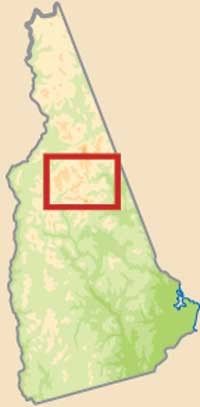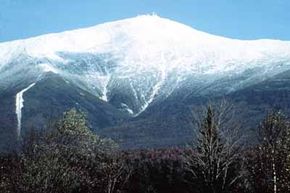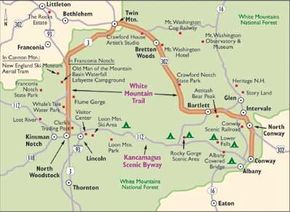Archaeological Qualities of White Mountain Trail
There are many archaeologically significant sites along this byway. However, in order to preserve these sites, they are kept secret. If you have a serious interest in the locations and work being done at these sites, contact one of the local ranger stations.
Qualities of White Mountain Trail
The influx of tourism and the development of the lumber industry spurred the development of many towns throughout this region. The history of this growth is found in the historic structures that remain in towns such as Bartlett, Conway, and North Conway. Along the trail there are numerous sites that are already on the National Register of Historic Places or are eligible to be placed on this National Register. These sites represent a range of different cultures and time periods. Examples include the Mount Washington Hotel, the Abenaki Indian Shop and Camp, the Crawford House Artist's Studio, and the North Conway Depot and Railroad Yard.
Qualities of White Mountain Trail
There are many historical events associated with the White Mountain Trail. Some of these events include the creation of towns, villages, national forests, resorts, hotels, and the railroad.
The White Mountains were originally home to the Abenakis and other Native Americans. At the beginning of the 19th century, the White Mountains were a place for artists and others. The White Mountain School of Art was a group of landscape painters that included Thomas Cole, Benjamin Champney, and Frank Shapleigh. Also during this era, Nathaniel Hawthorne and Reverend Thomas Starr King captured readers' imaginations with tales of the White Mountains.
By 1891, Crawford Railroad Station stood at the top of Crawford Notch. This railroad was a magnificent feat of engineering given the region's terrain, climate, and isolation. The Frankenstein Trestle, which supports railroad tracks below the cliff in Crawford Notch, still makes observers gasp.
As access to the White Mountains improved, a series of ever-grander inns, hotels, and resorts was constructed to meet the needs of an increasingly affluent clientele. The most elegant of these, the Mount Washington Hotel, was the setting of the historic Bretton Woods Monetary Conference in 1944. It was at this conference where the dollar was set as the standard of international currency, earning the hotel a place on the list of National Historic Landmarks. This event, combined with the hotel's spectacular setting, contributed to its success as a thriving resort and stunning landmark.
The 1923 demise of another grand hotel, the Profile House, and the subsequent sale of its land to the Society for the Protection of the New Hampshire Forests and the State of New Hampshire, resulted in the creation of Franconia Notch State Park. More than 15,000 people, including children, contributed funds to make this purchase possible.
Five sites are listed on the National Register of Historic Places. Eleven individual sites and three historic districts are also eligible for the National Register of Historic Places. These sites represent historic structures used for religion, commerce, transportation, and residential needs.
Logging towns, such as Carrigain in Crawford Notch, appeared and vanished as the harvest swept through the notches, surviving only as the names of mountains, hiking trails, and state historic markers. The movement to conserve tracts of forestland was, in part, a reaction to the large-scale lumber cutting that alarmed early conservationists.
The creation of the National Forest System occurred just as the automobile age commenced. This assured Americans an opportunity to vacation a world away from the citied world, yet still be within driving distance of the great eastern cities. The visible evidence of the preceding ages is now as much a part of the physical landscape as the towering granite cliffs and soaring mountains of the White Mountain Trail.
Natural Qualities of White Mountain Trail
The White Mountain Trail is surrounded by glaciated mountains, swamps, and lakes. Elevations along the trail range from 500 to 4,000 feet, and a few isolated peaks are even higher than 5,000 feet. Summers along the route are warm, and precipitation is evenly distributed throughout the year. However, winter can be severely cold. The average length of the frost-free period is about 100 days, and the average annual snowfall is more than 100 inches.
This region is in the transition zone between the spruce-fir forest to the north and the deciduous forest to the south. Valley hardwood forests are composed of sugar maple, yellow birch, beech, and hemlock trees. Low mountain slopes support spruce, fir, maple, beech, and birch trees. Higher on the mountain, you can find pure stands of balsam fir and red spruce which devolve into Krummholz at higher elevations. Alpine meadow, a tundra-like growth, is found above the timberline on Mount Washington.
The wildlife in this area is the same as the wildlife that is found in both the mixed forest and boreal forest. However, some species are unique to the trail's alpine tundra, such as the long-tail shrew, boreal redback vole, gray-cheeked thrush, spruce grouse, and gray jay.
Qualities of White Mountain Trail
There are plenty of places to hike, fish, sightsee, downhill and cross-country ski, camp, and mountain bike along the White Mountain Trail. Hiking trailheads dominate the roadway on both sides. There are great hiking trails for families, day hikers, and backpackers. The Crawford Path is the oldest (1819) continually maintained footpath in the United States. Twenty 4,000-foot mountains are located along this byway as well.
Fly-fishers can find heaven if they hike a bit to mountain lakes and streams. This wilderness also offers some of the most breathtaking ski slopes in the East.
Find more useful information related to New Hampshire's White Mountain Trail:
- New Hampshire Scenic Drives: White Mountain Trail is just one of the scenic byways in New Hampshire. Check out the others.
- How to Drive Economically: Fuel economy is a major concern when you're on a driving trip. Learn how to get better gas mileage.


